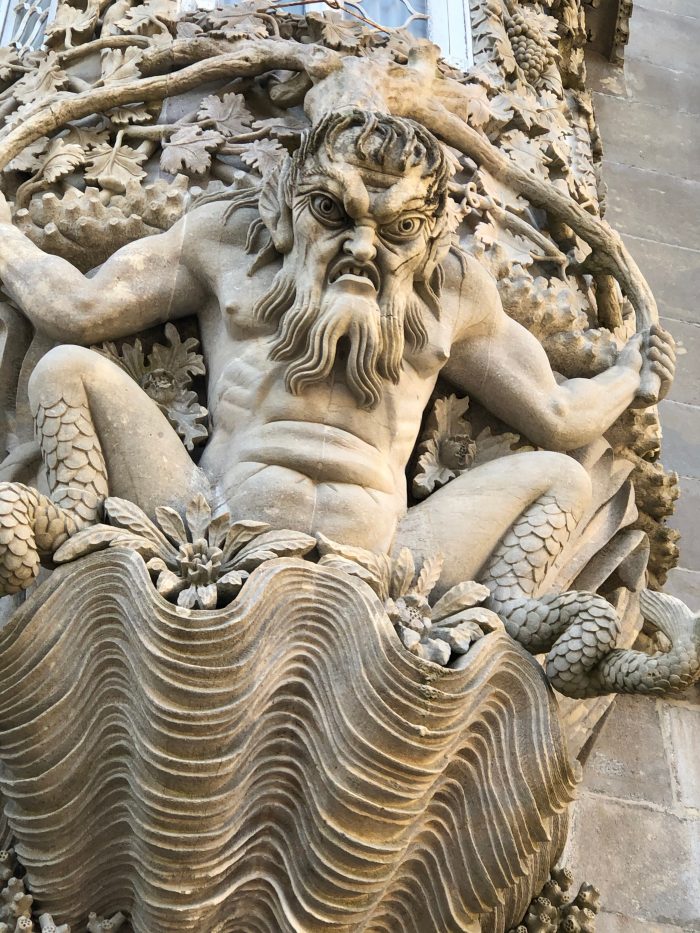Escape the Cloud of Coronavirus with Daydreaming
For those of you who itch to travel—-I am truly sorry. You’re probably not going anywhere for a while. And so, in order to feed your wandering soul in the meantime, you have two choices: either dredge up memories of past trips to relive your joy of discovery or imagine new places that you have yet to visit so that you can dream of a future with crowded planes and crying babies, people actually hugging, and markets filled with fresh cheese, fish and meat….and an overabundance of toilet paper.
I would like to provide you with some dream possibilities from my trip several weeks ago to Portugal. I came back right under the wire, in a plane half empty and with people eyeing coughers suspiciously.
It’s OK if I’m Stuck in Portugal; I Already Like Linguica
First I will tell you that I had a list of other ideas for travel blogs…..and then everything changed with the coronavirus pandemic. My brother, who is 75 years old and has never been to Europe or been on a vacation in 40 years, had just made plans to fly to Portugal solo, rent a car, and wander.
I wrote to him yesterday and told him that he might not be able to return because of coronavirus, and he said, “Well, I can learn Portuguese. I already like linguica.” I told him that he needed to cash those tickets in—if possible—and daydream about Portugal for a future trip.
What to Do if You are in the Travel Business
Many of the people with whom I communicate online and in person are travel fans like me. Some make their living from writing about travel, some from planning tours, and others by accompanying people who travel. They, like millions more, are feeling the impact of the virus and the travel restrictions. We are all at sea and waiting to see what develops and when.
Travel Blogs Replaced by Daydreaming
My list of travel ideas are put on hold: funny stories about roommates abroad (I have 125 entertaining stories from a travel site for older women); tales of the history of the Portuguese tiles (called azulejos); the story of bacalhau, Portugal’s national dish; an interview with an intrepid 82-year old traveler, hiker, and geocacher; and more. What I have ended up doing instead is posting photos of my daughter when she was a baby: this is dire.
Everything seems to be changing on a daily basis, mostly for the worse, but fortunately blogs can be amended and I hope to be writing about the end of this particular nightmare soon.
Dreaming of Paris, Barcelona, Bora Bora, or yes, China
Since the coronavirus pandemic has changed travel plans for millions, perhaps we all need to travel in our imaginations for the time being, whether to Paris, Barcelona, Bora Bora, or yes, China (or, of course, you can love the beautiful places nearby, as does my traveling pal Lewanda). I’d like to suggest several places for inspiration, to be folded and set aside until we emerge from this nightmare.
A Suggestion—Imagine Sintra, Portugal: Daydreamer’s Destination
One magical future destination might be Sintra, Portugal. Sintra has faced disasters in years past and has made it through floods, fires, and earthquakes and has recreated itself again and again. The nature and buildings—-most notably the Pena Palace—have preserved a dream-like allure for millions of people through the years.
“Today is the happiest day of my life. I know Italy, Sicily, Greece and Egypt, and I have never seen anything, anything, to match the Pena. It is the most beautiful thing I have ever seen…. the Castle of the Holy Grail.”
Richard Strauss, German Composer
“Sintra (is) where nature and art complete each other wonderfully.
Hans Christian Anderson, Danish Writer
Pena Palace, Sintra
A wedding cake, Disneyland for adults, a fairy-tale castle, a slightly drugged dream, or as Lord Byron described it, “glorious Eden….,” the Pena palace is in Sintra, Portugal. It is a UNESCO World Heritage Site long popular with writers, artists, local school groups, and tourists from all over the world.
I went to Sintra a few weeks ago, on a perfectly sunny and cool day in late February. Throughout my journey I had the steady and helpful presence of the wonderful Ines, who often works with Road Scholar, a popular American not-for-profit organization that provides educational travel programs.
Sintra is about 16 km north of the coastal resort of Cascais. If you travel on the coast road, you’ll pass Praia do Guincho, a beach popular with surfers, and the cliffs of Cabo da Rocha. The road from Cabo da Rocha to Sintra wends its way through the heart of the Sintra-Cascais National Park and soon the Moorish, Arabic, Gothic and Romantic spires of Sintra rise in the distance through the forest greenery.
Once in Sintra, you can hop on a bus that chugs up the mountain (or if you are more intrepid, you can hike the steep 480m hill) to the heights of the Pena Palace (Palácio Nacional de Pena), the creation of King Consort Fernando II of Saxe Coburg, husband of Queen Maria of Portugal. While the Pena Palace from a distance is inspiring, seeing it up-close is dizzying.
Ferdinand’s Fevered Dream
The Pena, first built in the 12th century as a chapel dedicated to Our Lady of Pena, had expanded into a monastery by the 16th century. While the site deteriorated, the Great Lisbon Earthquake of 1755 completed the destruction. By 1838, when the existing structure and surrounding lands were purchased by Ferdinand, the only part of the building that was still intact was the original chapel.
Ferdinand oversaw the creation of the Pena, which was largely inspired by the palaces and castles of Bavaria, with elements of Moorish, Gothic, and Manueline (Portuguese late Gothic) styles. Although the palace retained the church cloister and refectory from the 16th century building, the outer structure was something completely different—-a new expression of the Romantic Movement and a unique and fantastic edifice.
In 1996 Pena Palace underwent a restoration project that included repainting the exterior walls the bright original colors, which horrified some of the residents of Sintra.
A vast park surrounds the Pena, with rare and exotic trees and decorated with fountains, ponds, cottages, ruins, and paths. Thousands of trees have been planted to add to the oaks and umbrella pines already there.
Pena Palace was listed on the UNESCO World Heritage List in 1995, with the description, “structures harmonize indigenous flora with a refined and cultivated landscape created by man as a result of literary and artistic influences.”
One of my favorite parts of the Palace is the sculpture of a monstrous half-man, half-fish Triton, looking down on the hordes of tourists making their way to the Pena’s entrance. There are several possible origins to the story of Triton. The one most familiar to Portuguese would be the following selection from Canto IV of the 16th century national epic poem The Lusiads by Luís de Camões, which celebrates the Portuguese Age of Exploration and the creatures it found in Africa and India on its way to forging a naval empire.
“This was a big beast, black and ugly, (…)
With a hairy beard that fell downwards
From the head to the shoulders, they were all
Some water weeds soaked with water, and well it would seem
That no smooth comb had ever met”.
Luís de Camões, The Lusiads
Other memorable buildings nearby include the National Palace, with its unique conical chimneys, recognized as one of the best preserved medieval palaces in the country. Built in the 15th century, it was the royal residence of Portugal’s nobility for four centuries.
The Palace of Monserrate, surrounded by world-class gardens, is not far from the 16th century Convento dos Capuchos, where Franciscan friars lived in austerity, and the Castelo dos Mouros, or Castle of the Moors, a 10th-century stone fortress with amazing views to the Atlantic Ocean and the Pena Palace. Downtown is the Quinta da Regaleira, a 20th-century building that was originally a residence but is now a museum, with caves, underground wells, towers, and a sculpture garden.
Take a moment to daydream about Sintra and its magical buildings and gardens! And plan for the day—hopefully soon—when you can actually fly to Lisbon and take the short trip to the mountains to Sintra. Even better—plan a trip to both Sintra and Cascais, just down the coast.
Cascais: Heartbreakingly Beautiful Daydream
Cascais is so different from Sintra—it is a beach resort with some notable historic buildings, black-and-white tiled sidewalks, great restaurants, glorious beaches, an ancient fort: it is the stuff of dreams about which I will write in the future. Here is a taste of what you will find there. Happy dreams….







Read 0 comments and reply